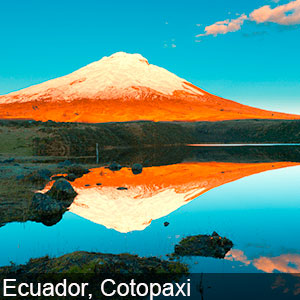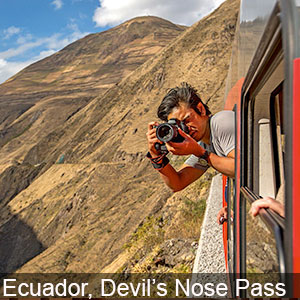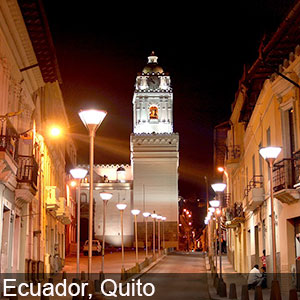
Wonders of Ecuador by Train
Overview / Highlights
6 NIGHTS / 7 DAYSEcuador is named after the Equator, the imaginary line around the Earth that splits the country in two. The smallest country in the rugged Andean highlands, Ecuador has an array of vibrant indigenous cultures, well-preserved colonial architecture, majestic volcanic landscapes and dense rainforest. This colorful tapestry of topography and people is presented in a country the size of the state of Nevada. Ecuador's central highlands are home to the famed volcanoes such as Cotopaxi (19,347 ft.) and Ecuador's capital city, Quito, originally an Inca city, recently declared a UNESCO Patrimonial Monument; and world renowned Indian Markets such as Otavalo. We invite you to enjoy this unique adventure aboard the Tren Crucero offers the best means of traversing Ecuador’s unique topography while offering an amazing land adventure in style and comfort. This fully loaded, golden-age-of-railroads-style train driven by a steam locomotives dating back to the beginning of the 20th century makes its way along dramatic 280-mile scenery of the Ecuadorian Andes, providing an unparalleled view of the transition from moorlands, through cloud forests, to tropical coastal landscape; traversing the Avenue of Volcanoes ascending to 12,000 feet before a dramatic descent down the famous Devil’s Nose to sea level.
CountriesEcuador | CitiesQuito, Cotopaxi, Latacunga, Guayaquil |
Tour Program Summery Outline
| Click |
Features
|
|
Interest
Adventure / Cosmapolitan Cities / Culinary / Cultural / Eco Tours / FAMILY ADVENTURES / Luxury



Day 1: Arrive Quito
Welcome to Quito, the Capital City of Ecuador. At an elevation of 10,000 feet and a mere 22 miles from the Equator, Quito is surrounded by natural beauty with mountains ringing the city, some volcanic, some with white capped peaks, lushly forested hills and a fertile valley. Long before the Spanish arrived, Quito was a major Inca city, destroyed by the Incas in a scorched earth policy that briefly halted the Spanish invasion. Back in 1564 Sebastián de Benalcázar recognized the importance of the city's location and founded San Francisco de Quito on top of the few ruins left him. As Ecuador’s Capital City, Quito is a mix of colonial history and modern buildings and has been designated as a UNESCO World Heritage Site.Meeting services and transfer to the Hotel Patio Andaluz, an elegant boutique hotel, a remodeled 16th-century home located in the heart of historic section of town “Quito Antiguo”, just a few minutes’ walk to the Plaza de la Independencia and the surrounding churches, museums and national monuments. Enjoy the enchantment and comforts that this boutique hotel offers, with large arches, balconies, interior patios and towering attics.
Overnight at the Hotel Patio Andaluz.
Day 2: Quito (City & Equatorial Monument Tours)
This morning we take a tour of Quito and surrounding. We visit the center of the city located downtown Quito, designated a UNESCO World Heritage Site. We will start with a panoramic view of Alameda Park and the Basilica, followed by a walk down the street of the Seven Crosses. Nest we take a walking tour, starting at Independence Square and continue to visit the presidential palace, the main cathedral, the gold-plated La Compañía Church, San Francisco Church and San Francisco Plaza.Next we head north to the Equatorial line for a visit to the Equatorial Monument marking the Middle of the World at latitude 0º, where you can stand with one foot on each side of the hemisphere. Visit the Ethnographic Museum inside the monument depicting various Native American groups living in Ecuador. Return to the hotel for overnight. Overnight at the Hotel Patio Andaluz. (B)
Day 3: Quito – Cotopaxi (Tren Crucero)
Morning transfer to the Chimbacalle train station in Quito where we board the Tren Crucero, a fully loaded, golden-age-of-railroads-style train driven by a steam locomotives dating back to the beginning of the 20th century. We make our way along dramatic 280-mile scenery of the Ecuadorian Andes, watching the transition from moorlands, through cloud forests, to tropical coastal landscapes. We traverse the Avenue of Volcanoes boasting more than 10 volcanoes and a scenic ride ascending to 12,000 ft and later descending down the famous Devil’s Nose to sea level. Along the route, there are several opportunities to meet Andean and coastal indigenous communities and witness their way of life. The carriages are First Class, decorated in Ecuadorian style, with historical references; train crew ensure exceptional on-board service.Our first stop will be the station located in El Boliche Recreational Area where we disembark from the train and we will take the bus to go to the Cotopaxi National Park viewing the spectacular and breathtaking high plains surrounding the magnificent snow-capped Cotopaxi - the earth's highest active volcano at 19347 ft. There we will do a short hike in the slopes of the volcano to enjoy the landscapes, the flora and fauna. Then we continue our trip and we will visit hacienda San Agustín del Callo located in the area to have a delicious lunch. In the afternoon we go to the train station in Lasso to be part of a traditional festivity.
Overnight and dinner at the La Cienega. (B,L,D)
Day 4: Cotopaxi – Latacunga – Riobamba (Tren Crucero)
Following breakfast we return by bus to Latacunga train station to board the train and continue our journey to the south. On the way we will stop to visit a rose plantation, where we can learn about the growing, harvesting and post-harvest processes of the roses. Next, we continue on the train to the city of Ambato where we will enjoy lunch at the hotel Roka Plaza located in a patrimonial house. After lunch we continue on board the train to the Urbina station which is located at 11,840 feet above sea level, being the highest train station in the country, here we visit the Interpretation Center or the Ice Men and enjoy the beauty of the landscape at the slopes of Chimborazo, the highest volcano in Ecuador. Following this visit we will transfer by bus to Hostería Abraspungo for dinner and overnight.Overnight at the Hostería Abraspungo. (B,L,D)
Day 5: Riobamba – Devil’s Nose – Bucay (Tren Crucero)
Early in the morning we leave the hotel to go to the Riobamba train station, here we will take the train to Colta to visit the Balbanera church, which is known as the first church built in Ecuador. Then we continue our journey by train to Guamote, where we will visit the main attractions of the city and the indigenous market, which is one of the largest and most important in the country. After this visit we will have lunch at the train station. This afternoon we return to the train station in Alausí and after a short stop we will continue our journey through the Devil's Nose; we will stop for a few minutes at the viewpoint to appreciate this important engineering work and to understand why it is called the most difficult train in the world due to the sheer rock wall known as the Nariz del Diablo (Devil’s Nose). Plans were started in 1874, but work only began in 1899 on the coast in Guayaquil and the train track zigzagged up to Alausi in 1902. The Devil's Nose is so steep that the train has to reverse up alternate bits of track in order to zigzag and make the decent around 7400 feet - considered almost impossible in railway engineering. The project was completed ending in Quito in 1908.We continue this awe-inspiring ride twisting through rivers and canyons, down the switchbacks of the 1,000-foot cliff known as the Devil’s Nose. We continue by train to Bucay while viewing the climatic transition between the Sierra and the Coast.
Overnight and dinner at Hosteria D’Franco. (B,L,D)
Day 6: Bucay – Duran – Guayaquil (Tren Crucero)
After breakfast, we will take a short walk in the forest near to the hotel, where we can appreciate some of the flora and fauna typical of the coast and we will also visit some of the plantations of the coastal region. Next we make our way to the Shuar community, an indigenous community that despite having migrated many years ago from the Amazon to the Coast; they still maintain their customs and traditions. After these visits, we will go to the ranch San Rafael for lunch; afterwards we will board the train to go to the Durán train station. Along the way we will pass through typical coast plantations such as bananas, sugarcane, rice, and we will travel aboard our antique train pulled by t he steam locomotive to Duran where we are transferred by car or bus to the Mansion del Rio, a premier boutique hotel in Guayaquil built in 1926 under the name of Villa San Antonio and restored in 2007. The Mansion del Rio rooms are decorated with an antique European style, enabling guests to have the experience of life in the 20th century with the comforts of the present time.Overnight at the Mansion del Rio. (B,L)
Day 7: Depart Guayaquil
Transfer to the airport for the flight back home.Note: Optional extension to the Galapagos Islands.
